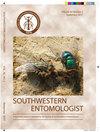Selección Masal de Pupas de Mayor Talla de Drosophila melanogaster1 Para Reproducir al Parasitoide Trichopria drosophilae2
IF 0.4
4区 农林科学
Q4 ENTOMOLOGY
引用次数: 0
Abstract
Worldwide, rearing of Trichopria drosophilae (Perkins) (Hymenoptera: Diapriidae) on Drosophila melanogaster Meigen (Diptera: Drosophilidae) (commercial host) is considered more advantageous than using D. suzukii (Matsumura), but D. melanogaster pupae are smaller. To increase the quality of T. drosophilae reproduced in D. melanogaster four populations were combined. From the pooled population a mass selection of larger pupae was made, and various biological parameters of the fly and the parasitoid were measured prior, during, and after mass selection. There were no biological differences in the four initial populations of D. melanogaster. The sizes of the fly and the emerged parasitoids in the selected pupae increased throughout the generations, stabilizing in the generation 15. The parasitoids that emerged from larger pupae were larger and more prolific. These results would allow the production of larger and more prolific parasitoids. The replicability of these mass selection techniques could improve the quality of T. drosophilae in other colonies where D. melanogaster is used.大量选择较大的黑腹果蝇蛹1,以繁殖果蝇毛虫2
在世界范围内,将果蝇毛蝇(Perkins)(膜翅目:双翅目:果蝇科)饲养在黑腹果蝇Meigen(双翅目:果蝇科)(商业寄主)上被认为比使用铃木果蝇(Matsumura)更有利,但黑腹果蝇的蛹较小。为提高果蝇在黑腹田鼠中的繁殖质量,将4个居群进行组合。从聚集的种群中选择较大的蛹,并在选择前、选择中和选择后测量了蝇和寄生蜂的各种生物学参数。4个初始居群间无生物学差异。所选蝇蛹的蝇体大小和出蛹寄生蜂的大小随世代的增加而增加,在第15代时趋于稳定。由较大的蛹产生的拟寄生物体型较大,数量较多。这些结果将允许生产更大、更多产的拟寄生物。这些大规模选择技术的可重复性可提高其他黑腹田鼠群体果蝇的质量。
本文章由计算机程序翻译,如有差异,请以英文原文为准。
求助全文
约1分钟内获得全文
求助全文
来源期刊

Southwestern Entomologist
生物-昆虫学
CiteScore
0.60
自引率
25.00%
发文量
95
审稿时长
6-12 weeks
期刊介绍:
Manuscripts submitted for consideration for publication in the Southwestern Entomologist should report results of entomological research in the southwestern United States or Mexico or should report results of studies on entomological species, relevant to this region, which may be done elsewhere, provided such results are geographically applicable. Manuscripts that report results of routine laboratory or field experiments for which the primary purpose is gathering baseline data or those that report results of a continuous evaluation program such as preliminary pesticide evaluation experiments, species lists with no supporting biological data, or preliminary plant resistance evaluations are not acceptable. However, reports of experiments with insecticides, acaricides, and microbials are acceptable if they are comprehensive and include data related to economics, resistance, toxicology, or other broad subject areas. Bibliographies will not be published in Southwestern Entomologist.
 求助内容:
求助内容: 应助结果提醒方式:
应助结果提醒方式:


